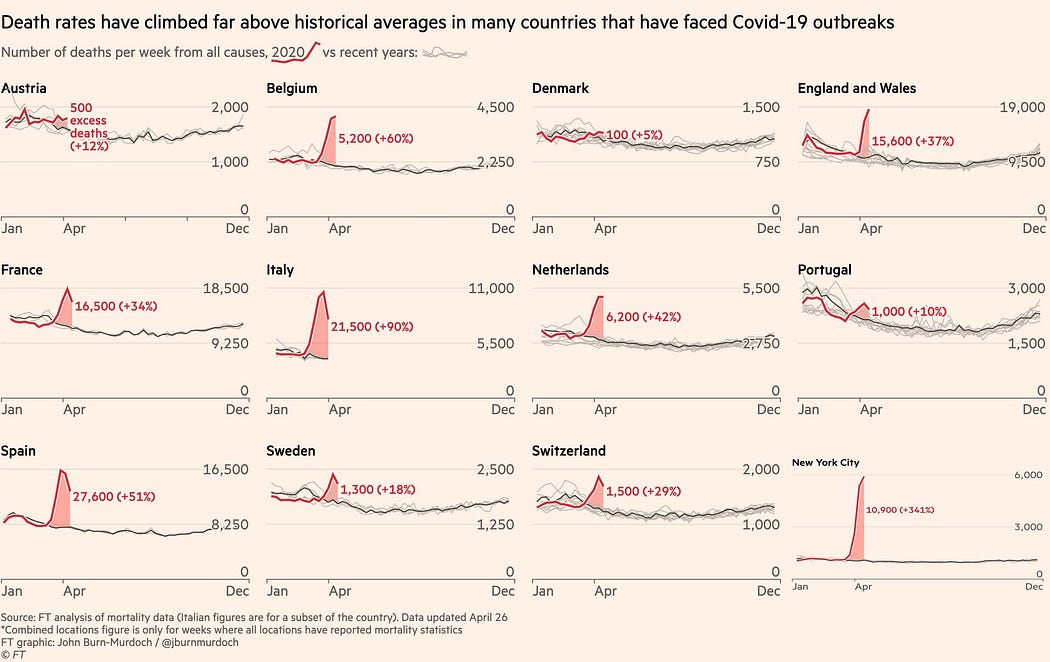Two articles which destroy the pandemic narrative...
... which anyone can understand
1. Reported excess deaths kicked off after lockdowns were instituted, not before.
Everyone should read this piece. It was published on Medium as long ago as May 2020 - which shows you how early people were “getting” this. The author is a John Pospichal from whom we have heard nothing since.
To my chagrin, I never saw this in 2020. If I had, I may have come to this realization sooner:
The default hypothesis must be that the state of pandemicity came about through the declaration that we were in one.
This is the key quote and graph:
We now have mortality data for the first few months of 2020 for many countries, and, as you might expect, there were steep increases associated with the beginning of the COVID-19 pandemic in each one.
Surprisingly, however, these increases did not begin before the lockdowns were imposed, but after. Moreover, in almost every case, they began immediately after. Often, mortality numbers were on a downward trend before suddenly reversing course after lockdowns were decreed.
This is an astonishing finding. But before I discuss its full import, and pose some questions to those who still defend the utility of lockdowns, I want to present the data that proves it.
The graph (which the author reproduced from the Financial Times):
2. Official data fails to show ANY mortality impact from the “pandemic”.
This piece by Arkmedic uses official data to show that there was:
no pandemic of lethality that made any statistically discernible blip on the world population.
The astute will be asking whether the observations in 1 above are consistent with those in 2.
They certainly aren’t inconsistent.
Firstly, the countries represented in 1 above actually represent only a small proportion of the world’s population, most of whom live in less well-developed countries. Moreover, it is the richest countries which suffered the worst reported mortality. (Weird, eh?)
Secondly, in many places the scary death spikes translated into much lower increases in mortality over the whole year, or even none at all.
For example, see Italy above. The FT claims weekly all-cause mortality peaked at 90% above expected.
Maybe it did (though personally I have doubts about the raw numbers), but even if it did, given that many of the deaths were people who were frail and elderly and expected to die soon after, the overall impact on age-adjusted all-cause mortality over the whole year is blunted, as can be seen by the graph below:
Note that the differences between years is artificially magnified as the X axis begins at 900, not zero.
In fact, age-adjusted all-cause mortality in Italy in 2020 was not dramatically greater than in many recent years - 1254 deaths / 100k compared to 1194 in 2015 and 1207 in 2012, and that is AFTER all the crazy dystopian treatment of the frail and elderly in 2020.
Thirdly, should we actually trust all-cause mortality data? Many people have assumed it is reliable as “governments can’t hide dead bodies”. This is naive. Given that we know that governments have lied about, obfuscated or downright forged much of the data in order to manipulate the public’s perception of what is actually happening in relation to “the pandemic”, why would we assume all-cause data is reliable?
There are, after all, many anecdotal stories from funeral homes which state they saw no significant increases in business in spring 2020 (but did from 2021).
As several of us including
and Martin Neil wrote, the numbers of deaths claimed in the NYC story look completely implausible, and the authorities should prove they happened:Finally, this very interesting tweet suggests that the number of obituaries in the USA was higher than the reported number of deaths in February 2020. This shouldn’t be possible. In fact, usually the number of obituaries each month is 40% lower than the number of deaths reported for that month (not everyone gets an obituary).
Is this evidence of authorities holding back the reporting of deaths occurring in February 2020 so they can artificially inflate the numbers later to support their chosen narrative?
Have another read of the quote I cited from the first article above. In light of the other points made, this bit is particularly interesting, isn’t it?
Often, mortality numbers were on a downward trend before suddenly reversing course after lockdowns were decreed.






Very interesting tweet, I'd not seen that.